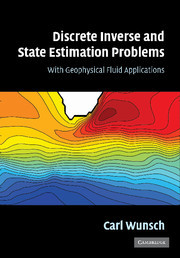Description
Discrete Inverse and State Estimation Problems
With Geophysical Fluid Applications
Author: Wunsch Carl
A 2006 introduction to inverse and state estimation problems for graduate students and researchers in oceanography, climate science, and geophysical fluid dynamics.
Language: English
Subject for Discrete Inverse and State Estimation Problems:
Discrete Inverse and State Estimation Problems
Publication date: 07-2012
Support: Print on demand
Publication date: 07-2012
Support: Print on demand
Approximative price 148.11 €
Subject to availability at the publisher.
Add to cart
Discrete inverse and state estimation problems: with geophysical fluid applications
Publication date: 06-2006
384 p. · 18x25.4 cm · Hardback
Publication date: 06-2006
384 p. · 18x25.4 cm · Hardback
Description
/li>Contents
/li>
The problems of making inferences about the natural world from noisy observations and imperfect theories occur in almost all scientific disciplines. This 2006 book addresses these problems using examples taken from geophysical fluid dynamics. It focuses on discrete formulations, both static and time-varying, known variously as inverse, state estimation or data assimilation problems. Starting with fundamental algebraic and statistical ideas, the book guides the reader through a range of inference tools including the singular value decomposition, Gauss-Markov and minimum variance estimates, Kalman filters and related smoothers, and adjoint (Lagrange multiplier) methods. The final chapters discuss a variety of practical applications to geophysical flow problems. Discrete Inverse and State Estimation Problems is an ideal introduction to the topic for graduate students and researchers in oceanography, meteorology, climate dynamics, and geophysical fluid dynamics. It is also accessible to a wider scientific audience; the only prerequisite is an understanding of linear algebra.
Preface; Part I. Fundamental Machinery: 1. Introduction; 2. Basic machinery; 3. Extensions of methods; 4. The time-dependent inverse problem: state estimation; 5. Time-dependent methods (continued); Part II. Applications: 6. Applications to steady problems; 7. Applications to time-dependent fluid problems; References; Index.
© 2024 LAVOISIER S.A.S.




